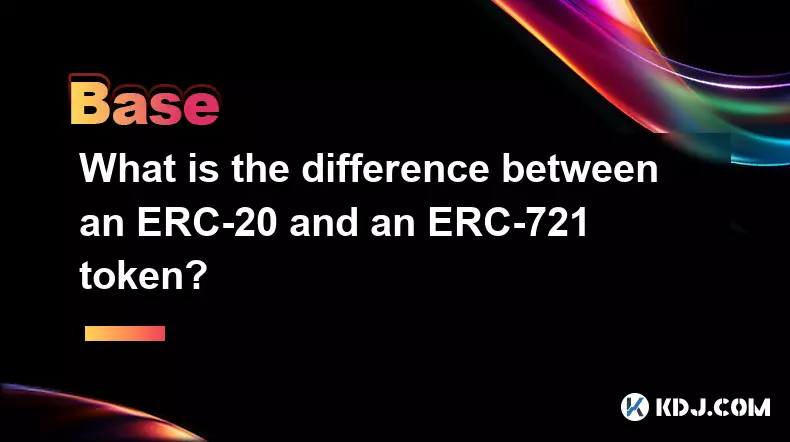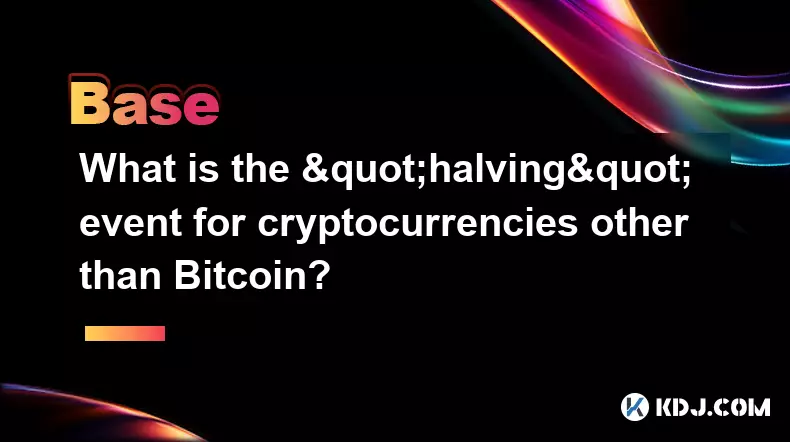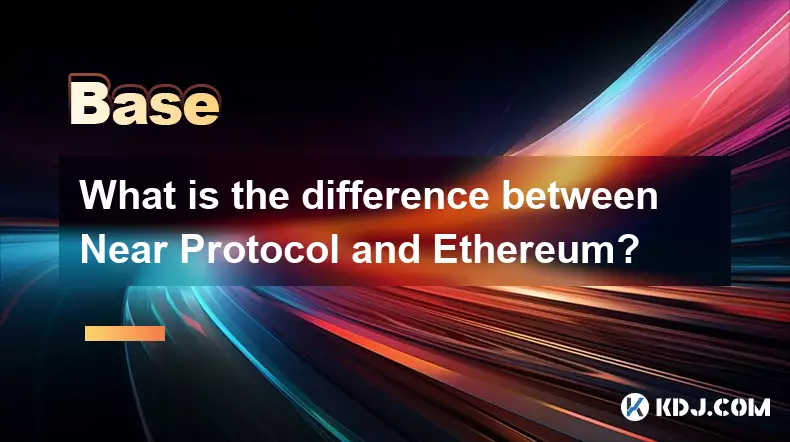-
 bitcoin
bitcoin $114206.058833 USD
-0.82% -
 ethereum
ethereum $4129.796871 USD
-1.31% -
 tether
tether $0.999964 USD
0.00% -
 xrp
xrp $2.640265 USD
-0.68% -
 bnb
bnb $1141.700384 USD
-0.18% -
 solana
solana $200.380665 USD
-2.05% -
 usd-coin
usd-coin $0.999888 USD
0.01% -
 dogecoin
dogecoin $0.200706 USD
-3.43% -
 tron
tron $0.299112 USD
-0.60% -
 cardano
cardano $0.668491 USD
-2.72% -
 hyperliquid
hyperliquid $46.924669 USD
-2.72% -
 chainlink
chainlink $18.286013 USD
-2.66% -
 bitcoin-cash
bitcoin-cash $555.734639 USD
-0.58% -
 stellar
stellar $0.323999 USD
-2.74% -
 ethena-usde
ethena-usde $0.999169 USD
0.00%
What is the difference between an ERC-20 and an ERC-721 token?
ERC-20 tokens are fungible and ideal for currencies or shares, while ERC-721 tokens are unique, powering NFTs in art, gaming, and digital ownership.
Oct 13, 2025 at 11:19 am

Understanding ERC-20 Tokens
1. ERC-20 is a technical standard used for smart contracts on the Ethereum blockchain to implement tokens that can be transferred and traded.
2. These tokens are fungible, meaning each token is identical in value and function to every other token of the same type.
3. They support basic functions like transferring tokens between addresses and querying account balances.
4. ERC-20 tokens are widely used in decentralized finance (DeFi) applications, initial coin offerings (ICOs), and as utility or governance tokens within dApps.
5. Their uniformity makes them ideal for representing currencies, shares, or points where interchangeability is essential.
Distinguishing Features of ERC-721 Tokens
1. Unlike ERC-20, ERC-721 defines a standard for non-fungible tokens (NFTs), where each token is unique and not interchangeable with another.
2. Each ERC-721 token has distinct metadata and ownership attributes, allowing it to represent one-of-a-kind digital assets such as art, collectibles, or real estate.
3. The standard enables tracking of individual token ownership and supports secure transfer mechanisms tailored for unique items.
4. NFT marketplaces and gaming platforms leverage ERC-721 to authenticate scarcity and provenance of digital goods.
5. Because no two ERC-721 tokens are the same, they enable new economic models based on digital ownership and verifiable rarity.
Fungibility and Use Cases in Practice
1. Fungibility in ERC-20 allows seamless exchange, similar to how one dollar bill can be swapped for another without loss of value.
2. This property supports high-volume trading and integration into financial systems requiring interchangeable units.
3. In contrast, ERC-721’s non-fungibility means each token carries specific data that differentiates it, such as artwork attributes or serial numbers.
4. A CryptoPunk NFT cannot be replaced by another Punk without considering its unique traits and market value.
5. Applications like digital identity, luxury authentication, and intellectual property rights benefit from the uniqueness enforced by ERC-721.
Technical Differences in Implementation
1. ERC-20 contracts manage a total supply and track balances using simple mappings of addresses to integer values.
2. Transfers in ERC-20 involve moving a specified quantity from one wallet to another, treating all tokens equally.
3. ERC-721 introduces a more complex structure, mapping each token ID to a specific owner, enabling individual tracking.
4. It includes functions to query which address owns a particular token ID and to approve third-party transfers of specific tokens.
5. Events emitted by ERC-721 contracts include the token ID during transfers, ensuring transparency about which exact asset changed hands.
Common Questions About ERC-20 and ERC-721
Q: Can an ERC-721 token represent fractional ownership?A: While ERC-721 tokens themselves are indivisible and non-fungible, protocols have been developed to allow fractionalization through companion tokens—often ERC-20s—that represent shares of an underlying NFT.
Q: Are ERC-20 tokens always tradable on exchanges?
A: Not necessarily. While many ERC-20 tokens are listed on centralized and decentralized exchanges, some may be restricted due to regulatory compliance, lack of liquidity, or design intent limiting transferability.
Q: Do ERC-721 tokens consume more gas than ERC-20 during transactions?
A: Generally yes. Due to their complexity and the need to handle unique identifiers and metadata, ERC-721 transfers typically require more computational resources and thus incur higher gas fees compared to standard ERC-20 transfers.
Q: Can a single smart contract include both ERC-20 and ERC-721 functionalities?
A: Yes. Developers can create hybrid contracts that adhere to multiple standards simultaneously, enabling a project to issue both fungible utility tokens and unique collectibles under one deployed contract.
Disclaimer:info@kdj.com
The information provided is not trading advice. kdj.com does not assume any responsibility for any investments made based on the information provided in this article. Cryptocurrencies are highly volatile and it is highly recommended that you invest with caution after thorough research!
If you believe that the content used on this website infringes your copyright, please contact us immediately (info@kdj.com) and we will delete it promptly.
- Essex Post Office, 5p Coins, and King Charles: A Royal Mint Revelation!
- 2025-10-23 10:30:16
- Waymo's Newark Airport AV Tests: Alphabet's AI Gamble Pays Off?
- 2025-10-23 10:30:16
- King Charles 5p Coins: A Royal Flush in Your Pocket?
- 2025-10-23 10:35:18
- Solana, Crypto Advisory, and Forward Industries: A New York Minute on the Future of Finance
- 2025-10-23 08:51:22
- MAGACOIN: Ethereum Whales Dive into the Hottest Presale of 2025
- 2025-10-23 08:51:22
- Kadena's End of the Road? KDA Token Plummets Amid Project Abandonment
- 2025-10-23 08:55:34
Related knowledge

How do decentralized identity (DID) solutions work?
Oct 14,2025 at 11:36pm
Understanding Decentralized Identity in the Blockchain Ecosystem1. Decentralized identity (DID) solutions are built on blockchain networks, allowing i...

What is the "halving" event for cryptocurrencies other than Bitcoin?
Oct 25,2025 at 12:19pm
Decentralized Exchanges Gain Momentum in 20241. Decentralized exchanges (DEXs) have seen a surge in trading volume as users prioritize control over th...

What is the difference between Near Protocol and Ethereum?
Oct 15,2025 at 08:01am
Near Protocol and Ethereum: Core Architectural Differences1. Near Protocol operates on a sharded blockchain architecture known as Nightshade, which al...

What does it mean for code to be "open source" in crypto?
Oct 12,2025 at 01:54pm
Understanding Open Source in the Cryptocurrency Ecosystem1. In the context of cryptocurrency, open source refers to software whose code is publicly ac...

What is the purpose of a "testnet"?
Oct 12,2025 at 09:01am
Understanding the Role of Testnets in Blockchain Development1. A testnet serves as a parallel version of a blockchain network, designed specifically f...

How to avoid phishing scams in crypto?
Oct 13,2025 at 06:18pm
Understanding Common Crypto Phishing Tactics1. Cybercriminals frequently use fake websites that mirror legitimate crypto exchanges or wallet platforms...

How do decentralized identity (DID) solutions work?
Oct 14,2025 at 11:36pm
Understanding Decentralized Identity in the Blockchain Ecosystem1. Decentralized identity (DID) solutions are built on blockchain networks, allowing i...

What is the "halving" event for cryptocurrencies other than Bitcoin?
Oct 25,2025 at 12:19pm
Decentralized Exchanges Gain Momentum in 20241. Decentralized exchanges (DEXs) have seen a surge in trading volume as users prioritize control over th...

What is the difference between Near Protocol and Ethereum?
Oct 15,2025 at 08:01am
Near Protocol and Ethereum: Core Architectural Differences1. Near Protocol operates on a sharded blockchain architecture known as Nightshade, which al...

What does it mean for code to be "open source" in crypto?
Oct 12,2025 at 01:54pm
Understanding Open Source in the Cryptocurrency Ecosystem1. In the context of cryptocurrency, open source refers to software whose code is publicly ac...

What is the purpose of a "testnet"?
Oct 12,2025 at 09:01am
Understanding the Role of Testnets in Blockchain Development1. A testnet serves as a parallel version of a blockchain network, designed specifically f...

How to avoid phishing scams in crypto?
Oct 13,2025 at 06:18pm
Understanding Common Crypto Phishing Tactics1. Cybercriminals frequently use fake websites that mirror legitimate crypto exchanges or wallet platforms...
See all articles










































































